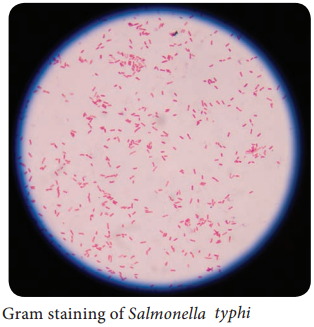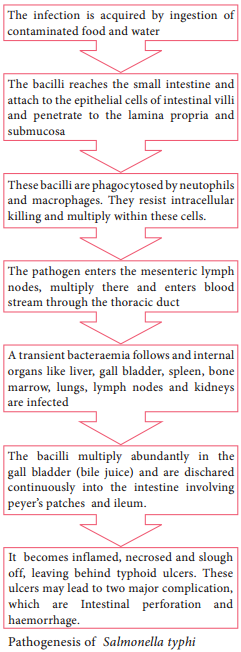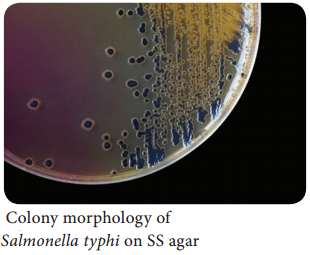Learninsta presents the core concepts of Microbiology with high-quality research papers and topical review articles.
Salmonella typhi of Bacteriology
The genus Salmonella consists of bacilli that parasites the intestines of vertebrates and human beings. It causes Enteric fever, which includes Typhoid and Paratyphoid fever. The most important species of the genus is Salmonella typhi which causes typhoid fever.
Morphology
Salmonellae are Gram – negative rods (1 – 3µm × 0.5 µm in size). They are motile with peritrichous flagella, non – capsulated and non – sporulated (Figure 7.14).

Cultural Characteristics
They are aerobic and facultative anaerobe, optimum temperature – 37°C and pH is 7 – 7.5. They grow on the following media and show the following characteristic colony morphology (Table 7.12).
Table 7.12: Colony morphology of Salmonella typhi
|
Media |
Colony Morphology |
| Nutrient Agar | Colonies are large, circular, smooth, translucent |
| MacConkey Agar | Colourless colonies (non – lactose fermenters) |
| SS – Agar | Colourless colonies with black centered. |
Pathogenicity
Salmonella typhi causes typhoid fever and its pathogenesis is discussed in flowchart 7.6.
Source of infection – food, feces, fingers, flies
Route of entry – faecal oralroute (ingestion)
Incubation period – 7 – 14 days

Clinical Manifestations
- The illness is usually gradual, with headache, malaise (feeling of discomfort), an2orexia (loss of appetite), coated tongue, abdominal discomfort with either constipation or diarrhea.
- Hepatosplenomegaly (enlargement of liver and spleen), step ladder pyrexia (continuous fever) and rose – spots (during 22nd or 3rd week).
Laboratory Diagnosis
Specimens:
Blood, stool and urine are the clinical samples collected from typhoid patients. The selection of relevant specimen depends upon duration of illness, which is very important for diagnosis (Table 7.13 & Figure 7.15).
Table 7.13: Specimen collection for typhoid
|
Duration of disease |
Specimen examination |
% Positivity |
| 1st Week | Blood culture | 90 |
| 22nd Week | Blood culture Faeces culture Widal test |
75 50 Low titer |
| 3rd Week | Widal test Blood culture Faeces culture |
80 – 100 60 80 |

The bacteriological diagnosis of enteric fever consists of the following methods, which are:
- Isolation of the bacilli
- Demonstration of antibodies
Isolation of the bacilli
The typhoid bacilli are isolatedfrom the following clinical specimens which are tabulated (Table 7.14).
Table 7.14: Isolation method of typhoid bacilli from various clinical speciments.
Demonstration of Antibodies:
Slide – agglutination: The isolate is identified by slide agglutination with ‘O’ and ‘H’ antisera.
Widal Test:
It is an agglutination test for detection of agglutinins ‘H’ and ‘O’ in patients with enteric fever. Salmonella antibodies start appearing in the serum at the end of 1st week and rise sharply during the 3rd week of enteric fever.
Prophylaxis
Various types of vaccine and their doses are given in Table 7.15.
Table 7.15: Various types of vaccine and their doses.
|
Vaccine |
Doses |
| TAB – Vaccine | 2 doses of 0.5 ml at an interval of 4-6 weeks |
| Typhoral | 3 doses on alternate days. It gives 65-96% protection for 3-5 years and is safe |
| Typhin – Vi | A single dose of 25µg |
Treatment and Control Measures
- Antibacterial therapy has been very effective in the treatment of patients.
- Ampicillin, amoxicillin and cotrimoxazole are useful in the treatment of typhoid fever.
- At present, ciprofloxacin is the drug of choice.
- Typhoid fever can be effectively controlled by sanitary measures for disposal of sewage, clean water supply and supervision of food processing and handling.